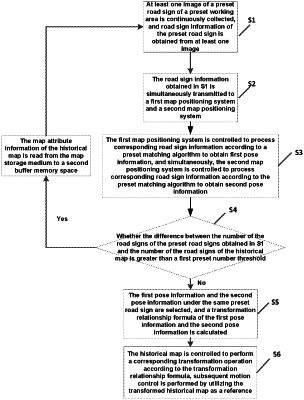| CPC G06V 20/582 (2022.01) [G01C 21/30 (2013.01); G06T 7/70 (2017.01); G06V 10/74 (2022.01)] | 5 Claims |

|
1. A historical map utilization method based on a vision robot, wherein the historical map utilization method is used for controlling a first map positioning system based on a current map and a second map positioning system based on a historical map to work independently from each other, the historical map utilization method comprising:
S1, controlling the vision robot to continuously collect at least one image of a preset road sign of a preset working area, and obtaining road sign information of the preset road sign from the least one image;
S2, simultaneously transmitting the road sign information obtained in S1 to the first map positioning system and the second map positioning system;
S3, controlling the first map positioning system to process corresponding road sign information according to a preset matching algorithm to obtain first pose information, and simultaneously controlling the second map positioning system to process corresponding road sign information according to the preset matching algorithm to obtain second pose information;
S4, selecting the first pose information and the second pose information under the same preset road sign, and calculating a transformation relationship formula of the first pose information and the second pose information; and
S5, controlling the historical map to perform a corresponding transformation operation according to the transformation relationship formula, and performing subsequent motion control by utilizing a transformed historical map as a reference;
wherein the historical map is an environment map which is built in advance and stored in a map storage medium and corresponds to the preset working area, the current map is an environment map built in real time in the preset working area, and the map storage medium is one storage unit within a system of the vision robot,
wherein S3 further comprises: outputting the first pose information from the first map positioning system to a first buffer memory space for waiting to be read for positioning, wherein the first buffer memory space caches map attribute information of the current map in real time; and
outputting the second pose information to a second buffer memory space from the second map positioning system for waiting to be read, wherein the second buffer memory space stores map attribute information corresponding to the historical map;
wherein, the map attribute information comprises a map identifier used for marking map data of the map storage medium, the number of road signs, a two-dimensional grid map, road sign information used for performing vision positioning, pose information output by transforming the road sign information, and check values of foregoing data, wherein the pose information comprises a position coordinate and an azimuth angle,
between S3 and S4, further comprising:
reading the map attribute information of the historical map, thereby obtaining the number of the road signs corresponding to the historical map; and
judging whether a difference value between the number of the road signs of the preset road signs obtained in S1 and the read number of the road signs is greater than a first preset number threshold, In case that the number of the road signs of the preset road signs obtained in S1 and the read number of the road signs is greater than a first preset number threshold, reading the map attribute information of the historical map from the map storage medium to the second buffer memory space, returning to S1, otherwise, entering S4,
wherein reading the map attribute information of the historical map comprises:
S401, judging whether the historical map exists in the map storage medium according to the map identifier, In case that the historical map exists in the map storage medium, entering S402, otherwise, entering S406;
S402, judging whether the number of the corresponding road signs in the map storage medium is greater than a second preset number threshold, In case that the number of the corresponding road signs in the map storage medium is greater than a second preset number threshold, entering S403, otherwise, entering S406;
S403, judging whether the number of the corresponding road signs in the map storage medium is greater than the number of the corresponding road signs in the second buffer memory space, In case that the number of the corresponding road signs in the map storage medium is greater than the number of the corresponding road signs in the second buffer memory space, entering S404, otherwise, entering S406;
S404, clearing the map attribute information stored in the second buffer memory space, reading the corresponding map attribute information from the map storage medium, caching the map attribute information to the second buffer memory space, and then entering S405;
S405, calculating a check value of data corresponding to the map attribute information buffered in the second buffer memory space, comparing the check value with a matched check value read from the map storage medium, if the check value is the same as the matched check value, determining that data read from the map storage medium is correct, then controlling the second map positioning system to process the map attribute information in the second buffer memory space so as to obtain new second pose information, then entering S406, otherwise, determining that the data read from the map storage medium is incorrect; and
S406, reading the second pose information from the second buffer memory space, and then entering S4.
|